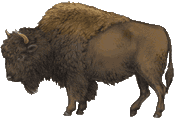|

Family Bovidae
Bison bison
Description: Dark brown overall; massive head with heavy, black, sharply curved horns (both sexes); heavy beard
from lower jaw; heavy growth of woolly hair covers the head and forequarters; large hump over shoulder. Bulls,
5 to 6 feet high at the shoulder; up to 2,200 pounds. Cows, 800 to 1,000 pounds.
Similar species: none.
Habitat/Distribution: Formerly inhabited grass lands throughout the region. Today found only in parks, refuges,
and game farms; not found in RMNP.
Food: Grasses, sedges, forbs, and some shrubs.
Herd animals, bison are usually found together. Groups often to twelve animals, consisting of cows, calves, and
young bulls appear to be the basic unit, but several of these groups may forage together to form large herds. Lone
animals are usually old bulls that have left the herds.
The rut, which occurs in August, stirs up a lot of activity, as the bulls try to establish or maintain their dominance
over rival bulls. Grunting and groaning fill the air as competing bulls push and shove each other with their massive
heads in an effort to prove they are stronger than their opponent. If that does not convince one or the other to
leave, they may back off about twenty feet and stand facing each other, bellowing and pawing the ground in a last
attempt to bluff the other into retreating. Then, simultaneously, they charge. Surprisingly agile for such massive
creatures, they reach top speed within a few steps and collide with each other like loaded freight trains. The
impact, accompanied by flying dust and debris, would seem to result in crushed skulls, but that is not the case.
One or two collisions is usually enough to convince the smaller and lighter of the bulls that enough is enough.
The usually lone calf is born in early spring. Prior to giving birth, the expectant mother wanders off to find
a secluded hollow in which to have her calf. Forty pounds at birth, the reddish brown youngster closely resembles
the calves of domestic cattle. Within a few days, the calf is strong enough to accompany its mother and the pair
return to the main herd. Unpredictable at any time of year, bison
|